By Cameron Wacker
The Great Chicago Fire completely altered the course of Chicago’s history. The raging fire took the streets by storm, taking the lives of 300 Chicagoans and nearly burning everything to the ground. But somehow deep within the orange flames that set the city ablaze, a silver lining peeked through: Chicago had a second chance.
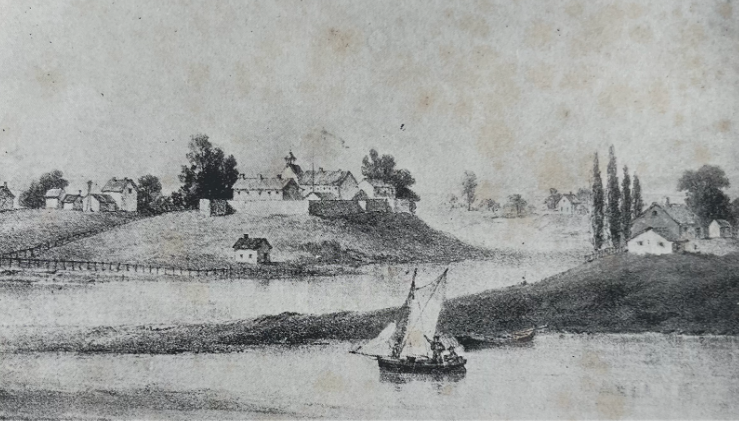
A picture of Chicago’s riverfront in 1831 from “Wacker’s Manual of the Plan of Chicago” by Walter D. Moody
Before the fire, Chicago was a growing city and outpost for travel and trade, eager to innovate and change with the rest of America. Though the fire was a devastating tragedy, it stimulated a grand new plan for Chicago, transforming the small city into an industrial hub and metropolitan hotspot.
The original plan for the rebuilding of Chicago was created by architects Daniel Burnham and Edward Bennett in 1909. Their plans for Chicago far surpassed the city’s state before the fire. They made their dreams for the city into a reality, with ideas such as a new park system, improved transportation methods, a grid street plan, and better sanitation efforts throughout the city. Once the plan was finished in 1909, it was ready to be presented to the citizens of Chicago.
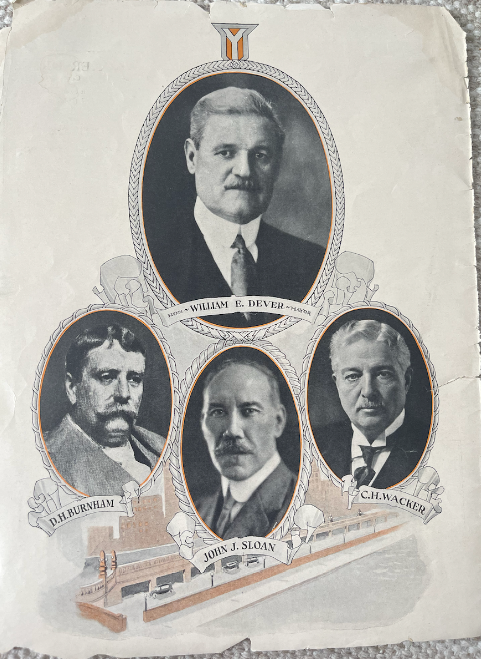
Photo collage of important figures during the rebuilding of Chicago, including past mayor William E. Dever, Architect Daniel H. Burnham, John J. Sloan, and past Chairman of Chicago Plan Commission Charles H. Wacker from “Souvenir of Wacker Drive Chicago” a pamphlet by Mid-Continent Construction Co.
To implement the Burnham and Bennett Plan, the Chicago Plan Commission was established. The group would be made up of many influential men who would help find funding for the project and disseminate information about the plan to the public. My great great grandfather Charles H. Wacker, a member of the Chicago Plan Commission, played an important part in the rebuilding of the city.
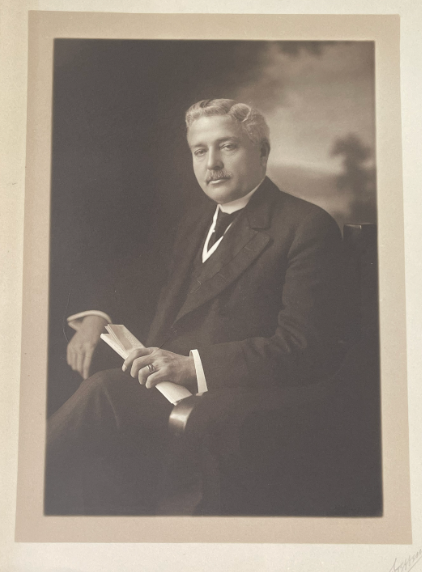
Portrait of Charles H. Wacker (family photo)
The son of two German immigrants, Wacker was born in Chicago on August 29, 1856. While he fulfilled many different roles in his lifetime, one of his most prominent and memorable commitments was his civic duty, namely working to help with the rebuilding of the city.

Book dedication from Chicago Plan Commission Managing Director Walter D. Moody to Charles H. Wacker
This book dedication and letter from Walter D. Moody to Charles H. Wacker truly underlines Wacker’s passion for the Burnham and Bennett plan. Wacker was eager to share the plan with the public, outlining the Burnham and Bennett plan in a textbook format to make it easy for citizens to understand. With brilliance, Moody wrote the “Wacker’s Manual of the Plan of Chicago”.

One-of-one copy of Walter D. Moody’s “Wacker’s Manual of the Plan of Chicago” given to Charles H. Wacker, now housed in my father’s library.

Handwritten letter from Walter D. Moody to Charles H. Wacker
Wacker was appointed to be chairman of the Chicago Plan Commission by past Mayor Fred A. Busse, serving in the position until 1926. Today, Wacker’s impact on Chicago and lasting memory is commemorated on the bustling Wacker Drive.
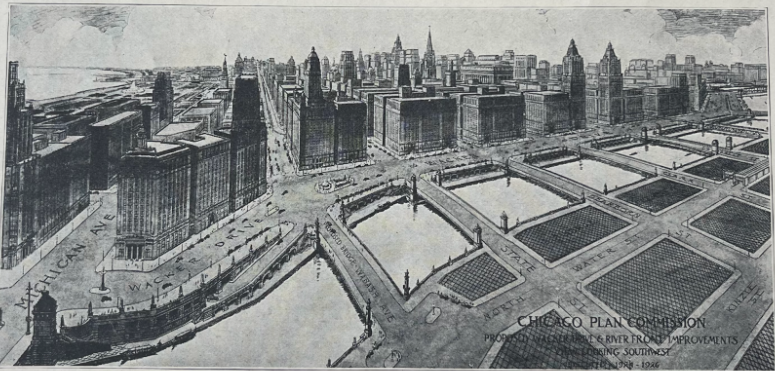
An architectural drawing of Wacker Drive before it was built from “Souvenir of Wacker Drive Chicago” a pamphlet by Mid-Continent Construction Co.
The Burnham and Bennett plan for Chicago was implemented using a bottom-up approach, allowing people with different expertise to help the commission create the most effective vision for the city’s rebuilding. In order to fund the rebuilding, the Chicago Plan Commission got donations from various outlets such as voluntary associations, individuals, and businesses.
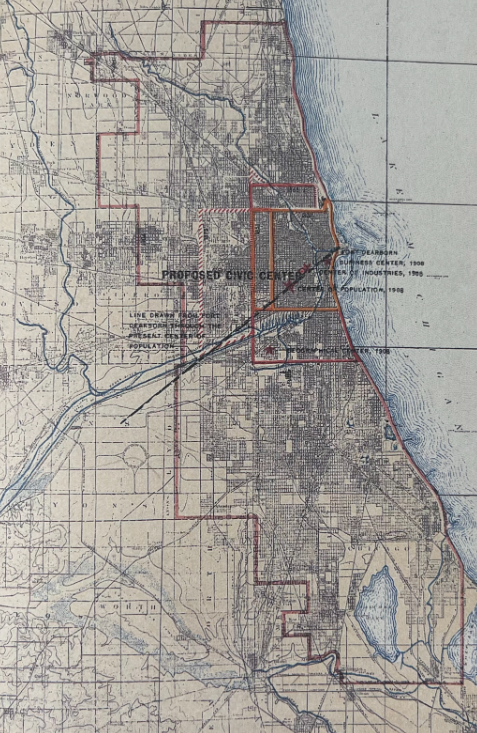
Map showing the successive city limits from “Burnham and Bennett Plan of Chicago,” courtesy of Commercial Club of Chicago, 1909
The newly-implemented grid street plan was vital to improving transportation throughout Chicago. Chicago’s previous street plan made it difficult for people to quickly move between different places, leading Burnham and Bennett to propose the idea of diagonal streets. The use of diagonal streets not only supported speedier transportation, but it also helped regulate traffic throughout the city.

Diagram of general scheme of street circulation from “Burnham and Bennett Plan of Chicago,” courtesy of Commercial Club of Chicago, 1909
Burnham and Bennett’s plan also utilized a circuit system, which systematically organized roads and made movement between districts much easier. The use of diagonal streets and a circuit system were linked together, creating a holistic grid for city planners to implement. Burnham and Bennett also recognized the necessity for transportation routes to surrounding suburbs, calling for highways and railroads to feed into the metropolitan hub.
Apart from necessary transportation improvements, the rebuilding of Chicago was the perfect time to beautify the city. Cleaning up the lake and river fronts not only invited citizens to enjoy the outdoors, but it also proved to be an economic advantage for the blossoming city. According to the Burnham and Bennett Plan of Chicago, the amount of waste disposed of in Lake Michigan was equivalent to waste covering 100 acres of land. By taking better care of the lake and river, the Chicago plan prevented the water supply from being poisoned, ultimately limiting economic expenses. The park system also began to boom, with the city plan creating numerous green spaces for residents and tourists to enjoy.

Section through the park proposed for South Shore from “Burnham and Bennett Plan of Chicago,” courtesy of Commercial Club of Chicago, 1909
Today, Chicago’s architectural and cultural beauty continues to flourish. Perhaps this “new” Chicago might have never been possible without the help of brilliant architects Burnham and Bennett and everyone on the Chicago Plan Commission. Thanks to the rebuilding of the city after the fire, many of us get to call this charming city home.
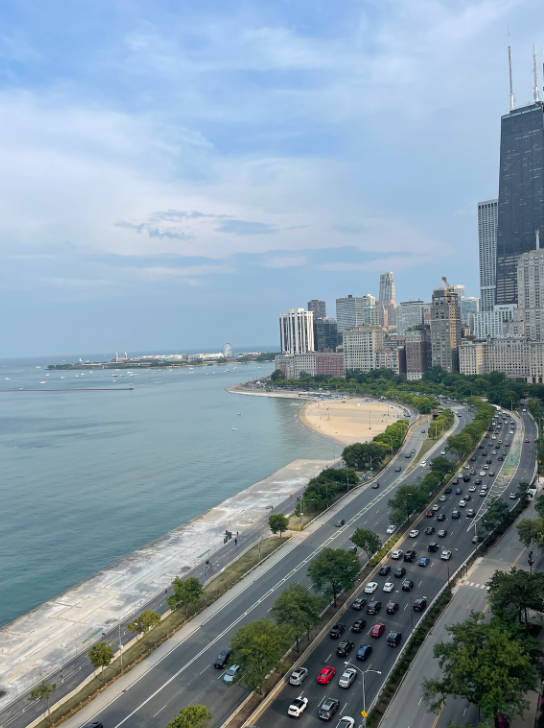
Photo of Lake Shore Drive today
To learn more about Burnham and Bennett’s Plan and the rebuilding of Chicago, I encourage you to check out “Wacker’s Manual of the Plan of Chicago” by Walter D. Moody and “Burnham and Bennett Plan of Chicago”. My story merely brushes the surface of an incredible rebuilding!






